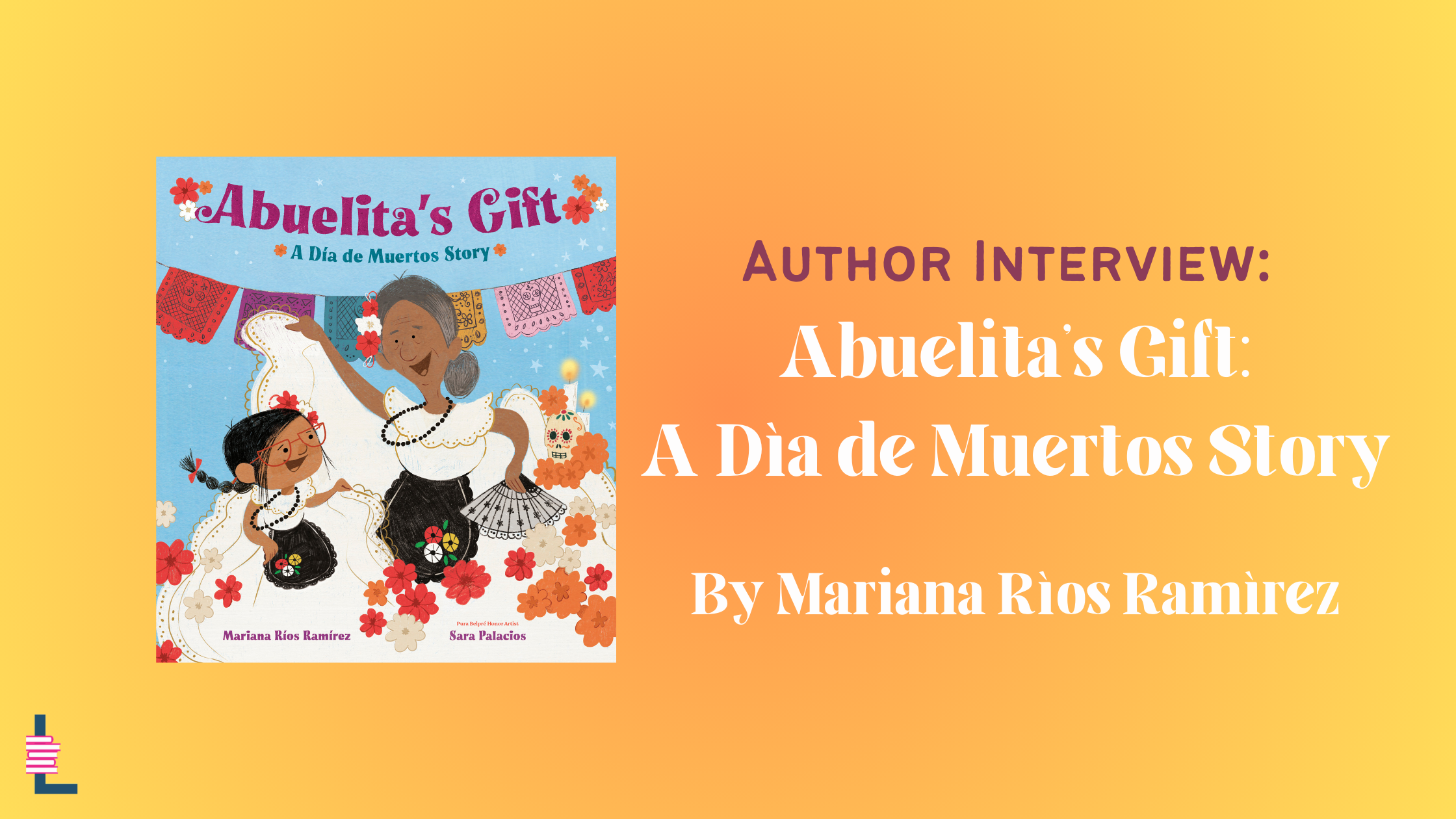Author Q&A: ‘Desert Song’ by Laekan Zea Kemp and Illustrated by Beatriz Gutiérrez Hernández
In the opening of the picture book, Desert Song, readers are brought into the harsh yet gorgeous desert landscape. A greater roadrunner looks into the distance, at the red-orange sun as it sets. There’s a row of distinct plants – prickly pear cacti among them. And nearby is a comfortable-looking house with a porch swing.
“The sun rules in the desert, telling us when to rise and when to sleep,” writes author Laekan Zea Kemp. “The sun sits atop the mountain while cracklings snap and hiss on the stove.”
Desert Song brings forth a story about the music that hums over one Texas desert night. The coyotes, cicadas and giant barn owls begin their song. And soon, the family in the big home joins in with music of their own. There’s Uncle Eduardo who drums his hands against his jeans, and the main character’s sister, Esme, who plays her maracas. Desert Song is both tender and larger-than-life; about the harmony between animals and humans, as well as the ancestral connections. Illustrations by Beatriz Gutiérrez Hernández are very detailed and breathe even more life to this story set in the desert.
Kemp spoke with Latinx in Publishing about the inspiration behind Desert Song (out now from Neal Porter Books), being in tune with nature, and more. Desert Song also has a Spanish-language edition that was simultaneously published, titled Canción del desierto.
This interview has been edited for clarity and brevity.
Amaris Castillo: Congratulations on Desert Song. What inspired this story?
Laekan Zea Kemp (LZK): With Desert Song, I really wanted to write a story about the feeling that I used to get (while) sitting on my grandparents’ back porch and looking up at the sky. They lived in a really small town, out in the country. West Texas is sort of known for our big skies and endless horizons. So originally, I just wanted to capture that feeling. But I wasn’t really sure how to construct a story around that. I was like, I think I need something a bit more dynamic.
And so even though I was never in a family band growing up, my partner was. And so I took inspiration from that to create the musical component, and have this family band become part of those natural desert sounds until they form this sort of symphony together.
AC: You begin this story by stating that the “sun rules in the desert.” I love this line. When people think of a desert, oftentimes what comes to mind is dry, barren land due in large part to the sun. What made you want to start Desert Song with this bold declaration about the sun?
LZK: I think I wanted to establish, from the beginning, that this is a family that is very in tune with nature. They respect it, they take their cues from nature and really see themselves a part of it, as much as the other animals and plant life that are in the desert. And because the animals and plants in the desert are really subjected to the sun’s rule – I mean it really does impact everything about their lives and survival – I just wanted that line to set the tone for how this family follows these rhythms and cycles of nature as well.
AC: Your book is a very sensory tale, with words that describe sounds and the mention of different musical instruments. Readers will see how animals join the main character and his family’s song. What message do you want to send about the relationship between humans and animals through this book?
LZK: I think it really goes back to that first line about the sun. I just really wanted to send the message that we are a part of nature. And more importantly, we’re not here to rule nature. We’re not just here to use it up as a resource. We’re here to commune with it. So as the sounds of the desert and the music the family is playing sort of become one over the course of the story, it’s meant to be this metaphor for being in harmony with the world around us. And how important and beautiful that is.
AC: In the book it is revealed that the family plays music for a very good reason. No spoilers, but it did make me think about one’s place in the world. It’s something that you address in your author’s note. Can you tell us more about that?
LZK: It’s kind of funny. I have several picture books forthcoming next year and the year after. And something that I realized as I’ve been talking about and promoting this particular book, is that I’m sort of a one-trick pony when it comes to picture books. [Laughs] I did not really do this on purpose, but I tend to write a lot about ancestors – especially in picture books. And just encouraging children to see themselves as part of something much larger.
I think with Desert Song, just like this family band’s performance is an homage to their ancestors, this story was really an homage to mine and how I really do feel like they’re with me when I’m creating. And how, more than anything, I just really want my art to honor them and make them proud. It’s something I think about a lot, which is why I think it comes up in my work so much. It’s something that just gives me a great sense of responsibility, in terms of making sure that I live a fruitful life that will hopefully leave the world better than I found it. I just hope the story encourages readers to think of themselves as part of a legacy like that. And to remember that their life is adding another chapter to their own family’s history, and therefore it’s important to make it a good one.
“ I think the heart of this story is really the fact that we are not alone. Like I said, we are all part of something much bigger. And I really hope leaders feel encouraged to tap into that connection and the power that comes with it.”
AC: How did you feel about the illustrations by Beatriz Gutiérrez Hernández and what do you think they added to the text?
LZK: They’re breathtaking, first and foremost. When it comes to picture books, one of my favorite parts of the entire process is being surprised by what the illustrator comes up with. I prefer to go in with zero expectations. I really don’t feel the need to be involved in that process at all. So I knew Beatriz was going to do an amazing job, but I was still blown away by the final product.
Not to get too technical, but I think one of the things that allows the text and the art to work so well together is not just the strengths of the text and the strengths of the illustrations, but also the choices that Beatriz and the design team made in terms of paginating – which is where you decide what text goes on what page and how scenes should be broken up to make room for the art, to provide that support or fill in those gaps.
Personally, I don’t paginate when I’m writing. I write, especially picture books, more like a poem. I break things up into stanzas and then let the illustrator and design team make those choices. I think the magic lies a lot in those page turns, and the choices that were made there – and how those choices make the world expand over the course of those page turns. There’s just like this build-up in the illustrations until you get to this very awe-inspiring spread that shows the characters looking up at their ancestors in the sky. It’s just so moving and beautiful. I think this is a book that, if you like picture books that feel more like art pieces or something that feels like a collectible piece of art, this is a perfect book for you.
AC: What do you hope readers take away from Desert Song?
LZK: Because these messages are for children, I really hope that they feel powerful when they read Desert Song. I also hope that it makes them feel loved, and that could be by their ancestors, their families, even the world around them. I also hope it makes them curious about their connections to those things, and what they can do to make those connections stronger – whether that’s going on a walk in nature, or cooking a meal with the people they love, or just speaking to their ancestors more often when they need guidance. I think the heart of this story is really the fact that we are not alone. Like I said, we are all part of something much bigger. And I really hope leaders feel encouraged to tap into that connection and the power that comes with it.
Laekan Zea Kemp is a writer living in Austin, Texas. She is the author of Somewhere Between Bitter and Sweet, a 2022 Pura Belpré Honor recipient, and several novels, as well as a picture book, A Crown for Corina. She has three objectives when it comes to storytelling: to make people laugh, cry, and crave Mexican food. Her work celebrates Chicana grit, resilience, creativity, and joy while exploring themes of identity and mental health.
Beatriz Gutiérrez Hernández is an illustrator and animator born and raised in Guadalajara, Mexico. She graduated from Pratt Institute with a BFA in Communications Design and lived in Brooklyn, New York, for several years. She is the illustrator of Dreams from Many Rivers, written by Margarita Engle, and the author and illustrator of Benito Juárez Fights for Justice. She splits her time between New York and Mexico.
Amaris Castillo is an award-winning journalist, writer, and the creator of Bodega Stories, a series featuring real stories from the corner store. Her writing has appeared in La Galería Magazine, Aster(ix) Journal, Spanglish Voces, PALABRITAS, Dominican Moms Be Like… (part of the Dominican Writers Association’s #DWACuenticos chapbook series), and most recently Quislaona: A Dominican Fantasy Anthology and Sana, Sana: Latinx Pain and Radical Visions for Healing and Justice. Her short story, “El Don,” was a prize finalist for the 2022 Elizabeth Nunez Caribbean-American Writers’ Prize by the Brooklyn Caribbean Literary Festival. She is a proud member of Latinx in Publishing’s Writers Mentorship Class of 2023 and lives in Florida with her family.
































